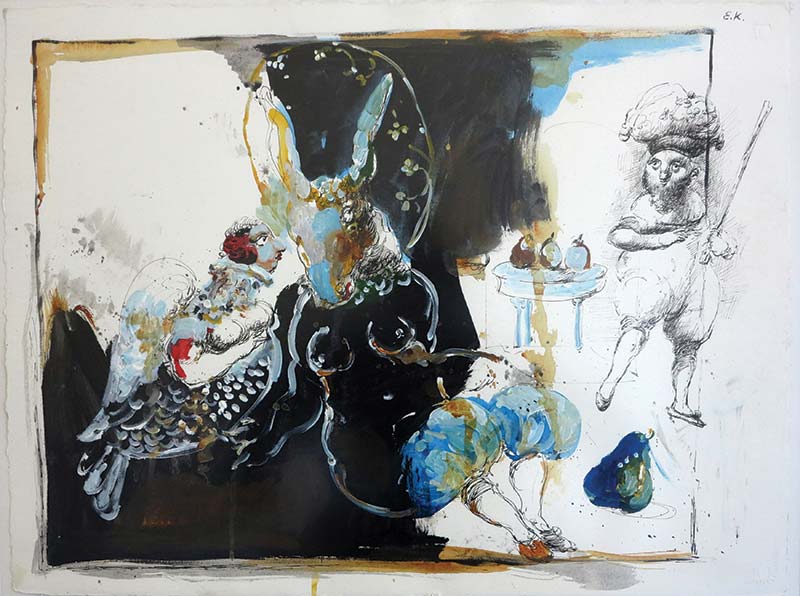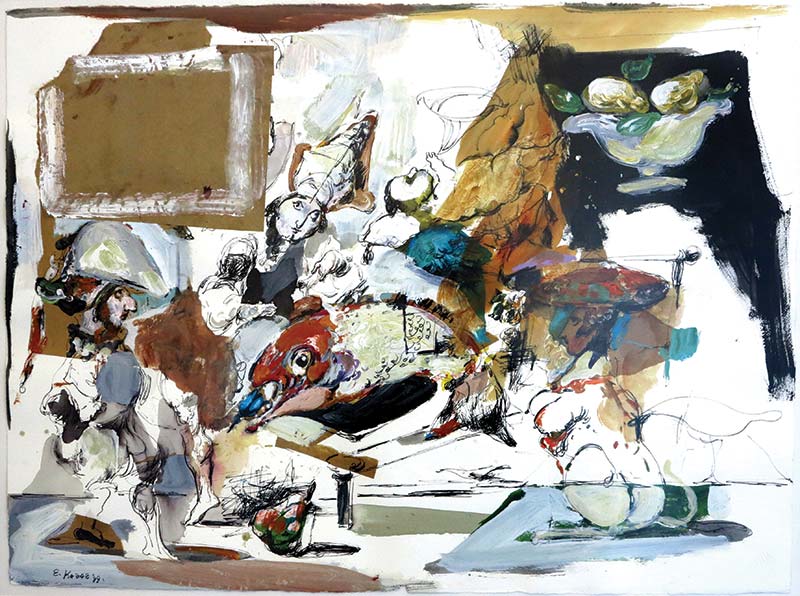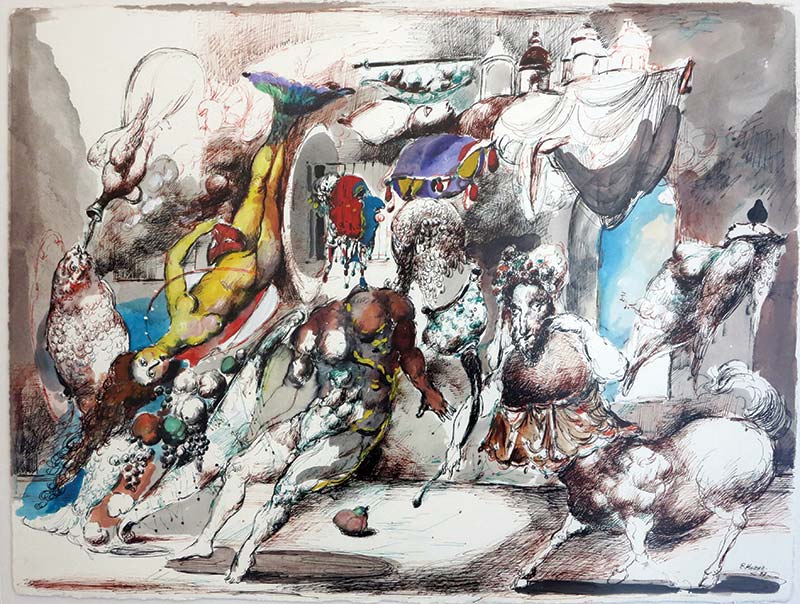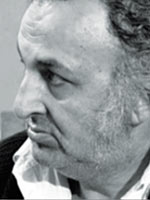Emil Kazaz

Donkis Redandou (Donkis Redandou), 2000

Balabon (Balabon), 1999

Wedding of Fish (Balığın Düğünü), 1997

The Backroom (Arka Oda), 1997

Madonna (Meryem Ana), 1997

Alberda (Alberda), 2000

Biography:
Born in 1953, Gyumri, Armenia
1965-1968 Studied at Merkourov Art School, Gyumri, Armenia
1968-1972 Studied at Panos Terlemezian Arts College, Yerevan, Armenia
1978 Garduated from the University of Fine Arts and Theater (with honors)
1980 Moved to Los Angeles, California (USA)
Lives and workes in Los Angeles, USA
Since 1968 constant participant of Republican and International exhibitions and International Art Fairs. His works are displayed at Modern Art Museum of Armenia, Museum of National Architecture and Urban Life (Gyumri, Armenia) and in private collections in USA, Germany, France, Switzerland and Russia.
Awards:
2007 El Grande Premio Lorenzo il Magnifico (Medici) in Sculpture, Florence Biennale
2003 Winner of the prestigious Lorenzo Medici medal, Florence Biennale
Exhibitions:
2015 Contemporary İstanbul Art Fair, Istanbul, Turkey
2013 Contemporary Istanbul Art Fair, Istanbul, Turkey
2012 Contemporary Istanbul Art Fair, Istanbul, Turkey
2009 International Fine Art Fair, Pasadena, USA
2008 Museum of Modern Art, Yerevan, Armenia
2008 ArtExpo, New York, USA
2008 The Armory Show, New York, USA
2008 Bridge International Art Fair, New York, USA
2008 SOFA New York, New York, USA
2007 International Fine Art Fair, Pasadena, USA
2007 International Fine Art Fair, San Francisco, USA
2007 Lev Moros Gallery, Los Angeles, USA
2007 Arame Art Gallery, Yerevan, Armenia
2007 Tina Zapoli Gallery, Porto Alegre, Brazil
2007 Roslin Art Gallery, Glendale, California, USA
2007 Leverisage Gallery, Carmel, California, USA
2007 Mooradian Fine Art, Los Angeles, USA
2007 Belador Art Gallery, Beverly Hills, California, USA
2007 Stephanies Art Gallery, La Canada, California, USA
2007 Bellian Art Center, Detroit, USA
2007 James Yaroush Gallery, New Jersey, USA
2007 Michael Levy Gallery, Long Beach, California, USA
2007 La Coupole, Saint-Loubes, France
2007 Florence Biennale, Florence, Italy
2007 ArtExpo, Las Vegas, USA
2007 Orangerie Du Luxemburg, Paris, France
2006 Leverisage Gallery, Carmel, California, USA
2006 Arame Art Gallery, Yerevan, Armenia
2006 James Yaroush Gallery, New Jersey, USA
2006 Bellador Gallery, Beverly Hills, California, USA
2006 Michael Levy Gallery, Long Beach, California, USA
2006 Roslin Art Gallery, Glendale, California, USA
2006 Stephanies Art Gallery, La Canada, California, USA
2006 Tina Zapoli Galley, Porto Alegre, Brazil
2006 Bellian Art Center, Detroit, USA
2006 Lev Moros Gallery, Los Angeles, USA
2006 Mooradian Fine Art, Los Angeles, USA
2006 Museum of National Architecture and Urban Life, Gyumri, Armenia
2006 Museum Of Contemporary Art, Yerevan, Armenia
2005 Tina Zapoli Gallery, Porto Alegre, Brazil
2005 Jamas Yaroush Gallery, New Jersey, USA
2005 Belian Art Center, Detroit, USA
2005 Michael Levy Gallery, Long Beach, California, USA
2005 Roslin Gallery, Glendale, California, USA
2005 Lev Moros Gallery, Los Angeles, USA
2005 Arame Art Gallery, Yerevan, Armenia
2005 Levernisage Gallery, Carmel, California, USA
2005 Gallery Vinizki, Munic, Germany
2005 Mooradian Fine Art, Los Angeles, USA
2003 Florence Biennale, Florence, Italy
2003 Museum of Modern Art, Yerevan, Armenia
2003 Museum of National Architecture & Urban Life, Gyumri, Armenia
2003 Belian Art Center, Detroit, USA
2003 Stephanies Art Gallery, La Canada, California, USA
2003 Roslin Art Gallery, Glendale, California, USA
2003 Gallery Vinizki, Munic, Germany
2003 Tina Zapoli Gallery, Porto Allegre, Brazil
2003 Art Territory, Los Angeles, USA
2003 Arame Art Gallery, Yerevan, Armenia
2003 James Yaroush Gallery, New Jersey, USA
2003 Michael Levy Gallery, Long Beach, USA
2003 Forest Lawn Museum, Glendale, California, USA
2002 Belian Art Center, Detroit, USA
2002 Roslin Art Gallery, Glendale, California, USA
2002 Gallery Vinizki, Munic, Germany
2002 Stephanies Art Gallery, La Canada, California, USA
2002 Tina Zapoli Gallery, Porto Allegre, Brazil
2002 Levernisage Gallery, Carmel, California, USA
2002 Denise Roberge Gallery, Palm Desert, California, USA
2002 Art Territory, Los Angeles, USA
2002 James Yaroush Gallery, New Jersey, USA
2002 Michael Levy Gallery, Long Beach, California, USA
2001 L.A. International Art Fair, Los Angeles, USA
2001 Brand Library and Art Gallery, Glendale, California, USA
2001 Art Santa Fe 2001, Santa Fe, USA
2001 Belian Art Center, Detroit, USA
2001 Palm Springs International Art Fair, Palm Springs, USA
2001 Roslin Art Gallery, Glendale, California, USA
2001 Gallery Vinizki, Munic, Germany
2001 Fletcher Gallery, Woodstock, NY, USA
2001 Tina Zapoli Gallery, Porto Allegre, Brazil
2001 Levernissage Gallery, Carmel, California, USA
2001 Galerie 224, Laguna Beach, California, USA
2001 Svit Ozor Fine Arts, Santa Barbara, USA
2001 Denise Roberge Gallery, Palm Desert, California, USA
2000 Gallery Vinizki, Munic, Germany
2000 Art Te2rritory, Los Angeles, USA
2000 Central Library and Art Center, Glendale, California, USA
2000 Belian Art Center, Detroit, USA
2000 Palm Springs International Art Fair, Palm Springs, USA
2000 Roslin Art Gallery, Glendale, California, USA
2000 Fletcher Gallery, Woodstock, NY, USA
2000 Herbert Palmer Gallery, West Hollywood, California, USA
2000 Tina Zapoli Gallery, Porto Allegre, Brazil
2000 Galerie 224, Laguna Beach, California, USA
2000 Levernissage Gallery, Carmel, California, USA
1999 Galerie 224, Laguna Beach, California, USA
1999 Art Territory, Los Angeles, USA
1999 Fletcher Gallery, Woodstock, NY, USA
1999 Brand Library and Art Center, Glendale, California, USA
1999 Downey Museum of Art, Downey, California, USA
1999 Belian Art Center, Detroit, USA
1999 Roslin Art Gallery, Glendale, California, USA
1999 Herbert Palmer Gallery, West Hollywood, California, USA
1999 Tina Zapoli Gallery, Porto Allegre, Brazil
1998 Brand Library and Art Center, Glendale, California, USA
1998 Art Territory, Los Angeles, USA
1998 Tina Zapoli Gallery, Porto Allegre, Brazil
1998 Roslin Art Gallery, Glendale, California, USA
1998 Belian Art Center, Detroit, USA
1998 Herbert Palmer Gallery, West Hollywood, California, USA
1998 Downey Museum of Art, Downey, California, USA
1997 Igitian Modern Art Gallery, Las Vegas, USA
1997 Roslin Art Gallery, Glendale, California, USA
1997 Tina Zapoli Gallery, Porto Allegre, Brazil
1997 Ashkenazy Gallery, West Hollywood, California, USA
1997 L.A. Central Library, Los Angeles, USA
1997 Belian Art Center, Detroit, USA
1997 Herbert Palmer Gallery, West Hollywood, California, USA
1996 Ashkenazy Gallery, West Hollywood, California, USA
1996 Roslin Art Gallery, Glendale, California, USA
1996 Igitian Modern Art Gallery, Las Vegas, USA
1996 Belian Art Center, Detroit, USA
1996 Tina Zapoli Gallery, Porto Allegre, Brazil
1995 Morosstudio Art Gallery, Santa Monica, USA
1995 C.F.M. Gallery, New York, USA
1995 Roslin Art Gallery, Glendale, California, USA
1994 C.F.M. Gallery, New York, USA
1994 Morosstudio Art Gallery, Santa Monica, USA
1994 Rosovsky Gallery, Laguna Beach, California, USA
1994 Lerner Gallery, Beverly Hills, California, USA
1994 New Trend Art, Hong Kong
1993 Rosovsky Gallery, Laguna Beach, California, USA
1993 International Art Gallery, West Hollywood, California, USA
1993 Morosstudio Art Gallery, Santa Monica, USA
1993 Whitney Gallery, Palos Verdes, California, USA
1992 L.A. Art Associations, Los Angeles, USA
1992 Morosstudio Art Gallery, Santa Monica, USA
1991 L.A. Art Associations, Los Angeles, USA
1991 Morosstudio Art Gallery, Santa Monica, USA
1991 Gallery Verona, Beverly Hills, California, USA
1989 Kathleen Spiegleman Gallery, West Hollywood, California, USA
1986 AGBU Art Gallery, Los Angeles, USA
1985 Orosco Gallery, Hollywood, California, USA
1983 Wine Street Gallery, Hollywood, California, USA
1980 Olympic Art Festival, Moscow, Russia
Reviews:
As a student Kazaz was exposed to non-Soviet art forms, and probably, his creative energy is more informed by those brief western-aesthetic interventions than he would like to admit (he is also quick to say he doesn’t look at other artist’s works). It is easier to establish his pictorial relationships within the complicated narratives and participatory nature of High Renaissance and Baroque painting. Roman figurative sculpture, the grandiose gestures of early Expressionism, Chagall’s search for archetype in everyday life. Of Gorky’s abstract expressionist nightmares, than in the social realist territories of his formal training. Kazaz’s work is born out of a revolutionary concept, at least from the former Soviet Union’s point of view, artistic liberty, product comodification and the creative freedom that encapsulate modernism.
When Kazaz left Armenia in 1980, it was still part of the Soviet Union. Following his immigration to the West, he did not become intoxicated with its material culture, conceptualism, or want to criticize or contrast its eco-political systems with his homeland as did many of his generation, i.e. the Sotsart. Instead of concerning himself with the obvious vulgarities of contemporary Western society, he looked inward in his search for answers to life’s central questions. He looked to the Church for answers too. Many of Kazaz’s works have religious underpinnings… “using religious elements within… works, mainly because Christianity was an integral and defining part of Armenian history, For Armenians, being Armenian and Christian is synonymous.”
A very inventive storyteller, Kazaz blurs the distinction between drawing, painting, and sculpture. By its spontaneous nature, drawing is his most fluid activity, followed by sculpture, and then painting, which, more often than not, seems sculptural. Kazaz is also a master of emotional transparency. His animated gestures and atypical postures project internal thoughts as secondary props, i.e. building details, cups, hats, etc. add to pictorial succulence and multilayered translations. All of his works are dominated by atmosphere, color, and implication; with a twist of the brush, a dab of color, or glob of clay, he creates a nose, a questioning gaze, and/or personal with complicated social situations as tiny pieces of architectural detail, furniture, or landscape identify locations in which his participants read their lines, and life their lives.
Emil Kazaz is an artist’s artist, an independent spirit and freethinker. He was taught the old fashioned way, extracted the best principles of his social realist training, added to them his adventures in the new world, and creates things no on else has ever seen. The work is saturated with humanist integrity. Whether using recognizable people – he often inserts himself into his paintings – human forms or morphed creatures existing within ornate psychological contractions like “Corsican Gate” or “Long Sheep,” his sense of emotional drama and visual physicality circumvent the rules of nature with unquestionable authority. They develop organically and, like life itself, evolve without preconceived plans or knowing their final destination.
In a sense, Kazaz has a lot in common with William Shakespeare, because both stage the world’s epic stores within highly controlled microenvironments. His art brings us closer to the fringe of human nature that most, attaches itself to something deep within each of us and, like cartographer, his imagination makes maps that locate new meanings within our own personal histories. We user the coordinates to fine ourselves within the loose and fluid human narrative that is never finished. There is nothing subtle about Kazaz’s connections. Whether on paper, linen, or cast in bronze, his well-crafted people, places and things, his poetics of imagination imitate nothing. They are real. However, in their presence it is not difficult for the viewer to be transported out of their time and place.
Adapted from "The Work of Emil Kazaz" by Joe Lewis.
***
Armenian born artist Emil Kazaz creates mythological grounded figures within a realm of half-light. His themes are a blend of sensual mysticism and provocative introspection -beauty, love and valor prevail. Kazaz's characters are original, acutely observed, and marvelously refreshing -especially considering how well worn this territory is. Although often obscured by the appearance of conformity to western classical figurative tradition, his sophisticated and culturally diverse aesthetic psychology produces a living rather than mummified iconography, not from frozen in time but archetype dancing to our collective internal rhythms. Once you recognize his anti-formal dances, the classicism becomes transparent.
Kazaz straddles the creative philosophies of two world cultures, East and West, bodies in constant flux. He twists conventions together. Iridescent Arabic manuscript illuminations romp with Western compositional restraints emotion and color confronting line and form. These myth shrouded figures push us around, disturb our choices and decisions, without slick faddism. They attach themselves to something deep within each of us, and, like cartographers, provide maps for our humanity
Early on, Kazaz abandoned the stiff realist paradise of his academic Soviet-styled Art School training, as well as the West's formalized penchant for abstraction and conceptualism. He sees both systems as obsolete and not helpful to the human catharsis within society. He also disclaims any connections to the self-centered political appropriateness advocated by much of today's criticism.
To paraphrase the poet John Dryden, Art is the "image of nature". All theories of Art have made some allowance for both terms: image, a thing in itself, a construct; and nature, what the Art addresses or imitates. Kazaz imitates nothing and creates everything, leaving nothing to chance. In his work, nature is more ontological than semantic. He moves people from the center of the contemporary universe and reconnects them to metaphysics of our collective past. Pushing the viewer into a thoroughly personal macrocosm, Kazaz does not subordinate his mythic and "supernatural" beings to anything. Not the fuming of a malevolent Old Testament God or the god haunted demiurge of Greek thought. His characters and situations exist in their present, always trying to meddle with their destiny, and like the adventurers of Homer, moving through unreal worlds of appearances where nothing is what it seems.
Kazaz's approach to Art brings us to the fringe of human nature. Masked by rich color, pattern and texture, attached to brilliant forms, Kazaz's attention to detail is never for its own sake. They are links that connect us to his reconstructed nature, philosophical fragments burning with supernatural potency, that set boundaries and make rules. Kazaz's powers of imitation and aesthetic judgment fool us into thinking we know his terrain. However, upon closer inspection, we find ourselves questioning our very nature while tightly holding on to what we believe, and accepting flux as stability.
There are countless gods, heroes, and demons in our world. You can find them everywhere. They are in Art, literature, and religion. Kazaz's vigilance catches these ethereal beings overseeing the normal routine of everyday people.
Emil Kazaz has been living in Los Angeles, California (USA) since the 80's, where he has been developing very successful international career.
Adapted from "Emil Kazaz" and "Nature and the Art of Emil Kazaz" by Joe Lewis.


